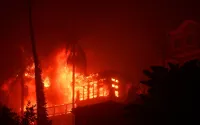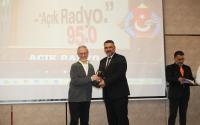13 February 2007James Sterngold, Chronicle Staff Writer
With the Bush administration and Congress fighting over how to rebuild the nuclear weapons complex, one of the country's top weapons designers said he believes it is time for the United States to consider a radical shift in policy that would ultimately eliminate the nuclear arsenal.
Joseph Martz, leader of a team designing a new generation of warheads at the Los Alamos National Laboratory, said in a series of interviews last week that he is troubled by how the debate on nuclear weapons policy in Washington is focused narrowly on the number of weapons needed for the future, and how they would be built, rather than on how to eradicate them entirely.
Lab officials originally refused to give Martz permission to be interviewed for this article. Martz, however, said he decided to speak anyway in order to press ideas that he believes can reduce the risk of nuclear war and carve out a central role for the weapons labs, which have been threatened with budget cuts. Martz emphasized that he was expressing only his personal views and not those of the lab. But his comments still represent the first time in recent years that a senior scientist inside the weapons program has proposed making disarmament a concrete policy goal.
Martz said the discussion in Washington needs to reflect technological breakthroughs found in two prime areas: the weapons maintenance program, known as stockpile stewardship, and the new weapon design initiative called the Reliable Replacement Warhead, or RRW.
Martz's aim is to help policymakers understand that, because of a more sophisticated grasp of weapons science, the United States can slowly dismantle its warheads and still protect itself. The country could also bolster its credibility as a leading voice for disarmament by ratifying the long-stalled treaty banning underground testing.
"The time is right," Martz said. "A confluence of events has now allowed the debate to progress, including the changes in Congress, the maturation of the stockpile stewardship program and the recognition by the military that RRW is feasible. A few years ago, we didn't have that."
The key to the new policy, he said, would be slowly reducing the number of warheads over a period of years, and during that time replacing older weapons with the new Reliable Replacement Warhead weapons as an interim phase. But the final goal, according to Martz, should be the elimination of the entire arsenal.
What the United States would retain in its place, he argued, would be the technology to assemble warheads from stockpiled materials if a grave threat to national security arose. The labs now have the capability to do that in a relatively short period of time, he said, without the need for testing. The U.S. nuclear deterrent would be transformed from thousands of weapons deployed on high alert to what has come to be known as the "virtual stockpile."
Martz, 41, described this view as part of the evolution in the thinking of a younger generation of weapons designers eager to rely more on science than missiles to deter foes.
"You understand what I'm offering here," he said. "I'm offering through our technological achievements the security we need to enter into a real discussion" of nuclear disarmament.
Martz believes the U.S. nuclear arsenal has been critical to the country's security and should be maintained for some years. But the nuclear policy debate, he said, has focused too much on producing new bombs and not enough on the next steps needed for broader arms control initiatives.
"I'm trying to offer solutions that say, 'How can we get the benefits of deterrence without having to put thousands of warheads on hair-trigger alert?' " he said.
Some of Martz's ideas have been discussed before, mostly among arms control experts, and there is disagreement over whether the country should deploy new generations of warheads, as Martz is proposing, even as an interim step. These experts argue that the current stockpile will be safe and reliable for decades, and that building new warheads is too provocative.
But this is the first time a senior official involved in maintaining Cold War-era warheads and designing the weapons of the future has proposed a long-term plan for eliminating them. Under current policy, officials say the world is too dangerous to consider eliminating the nuclear deterrent -- the U.S. now has more than 5,000 warheads -- which must be updated indefinitely.
Various treaties have reduced the size of the stockpile -- under the Moscow Treaty of 2002, the United States will decrease its deployed arsenal to 2,200 or fewer weapons by 2012 -- but actual disarmament has never been embraced as a concrete policy objective. In fact, even opponents of Martz's plan are pleased with his ideas, if only because it may inspire a debate on disarmament.
"We should be on a glide path to get to lower numbers of weapons," said Eugene Habiger, a retired air force general and former head of the U.S. Strategic Command, which manages the nuclear arsenal. "It's a glide path we've been on for years, but we need to think about the next step beyond the Moscow Treaty, and nobody is doing that yet."
Under the Reliable Replacement Warhead program, two design teams, one from Los Alamos and the other from the Lawrence Livermore National Laboratory, submitted plans in April for a new generation of warheads. They are supposed to be safer and more reliable than the older weapons, but they must be built without underground testing, which has never been done before.
A high-level government body, the Nuclear Weapons Council, is expected to announce shortly which design it has chosen, or whether, as some have suggested, it will propose a hybrid, combining elements of both.
Some experts, however, have been urging a deeper shift. Two widely-read opinion pieces published in the Wall Street Journal last month argued for total disarmament.
The essays -- the first by former Secretary of State George Shultz, former Defense Secretary William Perry, former Secretary of State Henry Kissinger and former Sen. Sam Nunn of Georgia, and the second by the former Soviet leader, Mikhail Gorbachev -- urged aggressive steps toward this long ignored goal.
"Reassertion of the vision of a world free of nuclear weapons and practical measures toward achieving that goal would be, and would be perceived as, a bold initiative consistent with America's moral heritage," the former U.S. officials wrote in their essay.
Martz's ideas get a mixed response from experts. Supporters of the weapons program maintain that it is naive to even talk about the elimination of the weapons in a dangerous world. Others argue that manufacturing new Reliable Replacement Warhead warheads is unnecessary under any conditions.
Steve Andreasen, who was involved in nuclear weapons policy in the Reagan, Bush and Clinton administrations, said he supports the concept of some kind of virtual nuclear force and elimination of the weapons, but opposes Martz's view that Reliable Replacement Warhead warheads ought to be produced and deployed as an interim step. He said it appears to be a way of maintaining the budgets at the weapons labs at a time when government officials have talked about big cuts, and that the new production could encourage more countries to consider weapons production.
"If someone at the labs is saying producing the RRW is essential for getting to our vision, I would not agree," said Andreasen.
Others say the issue is not so much numbers of weapons, but how much U.S. military policy relies on them. Robert Einhorn, a nuclear policy expert from the Clinton administration who favors arms control, said he believes the United States should boost its conventional power to make it more unlikely that it would ever need to use a nuclear bomb.
"We should be putting far more effort into developing more effective conventional weapons," he said. "It's hard to imagine a president using nuclear weapons under almost any circumstance, but no one doubts our willingness to use conventional weapons."
Martz acknowledged that he is motivated both by a desire to shape what he thinks could be a smarter policy debate and self-interest.
Los Alamos has been bitterly criticized in Washington for a series of security lapses, and some lawmakers have threatened to slash its work and budgets. The criticism has badly harmed morale at the lab, and Martz believes his ideas would, by enhancing the importance of the science done at the lab, help maintain budgets and job security, and also bolster a view that the labs can help reduce international tensions.
But he also sees in the virtual stockpile a program that would enable a new generation of weapons scientists to solve some of the policy conundrums left from the Cold War.
"In many ways, this answers the key question many people are asking, including people at the labs -- what is the role of the labs today?" Martz said. "To me the answer is simple. We become the deterrent in the 21st century."
Livermore appears to have edge in competition to design new warheads
Because of concern over security lapses at the Los Alamos National Laboratory, it appears unlikely that the lab will be declared the winner of a competition to design a new generation of nuclear warheads, according to Joseph Martz, head of the Los Alamos design team.
When Congress voted to authorize development of the new weapon, called the Reliable Replacement Warhead, or RRW, it called for the country's two weapons labs, Los Alamos and the Lawrence Livermore National Laboratory, to produce separate proposals.
Martz said the labs handed in their designs -- for a warhead to be fitted on submarine-based Trident missiles -- in April. He called the process revolutionary because the weapons have to be not only safer and more reliable than the current weapons in the stockpile, but the labs had to guarantee they could manufacture and deploy them without any underground testing, an unprecedented requirement.
The Livermore design essentially relied on a weapon developed but never deployed some years ago, which had been thoroughly tested, Martz said. Los Alamos took more of a chance by designing a warhead that used elements from previously tested designs, but combined them in a way that incorporated new safety features.
Those features, Martz said, were intended to prevent both accidental detonation and unauthorized use.
The Nuclear Weapons Council has been evaluating the two designs and is expected to render a decision soon.
Martz said there are rumors, which he has not confirmed, that the weapons council will order the two labs to combine the best elements of each design, but with Livermore in the lead role.
-- James Sterngold
E-mail James Sterngold at [email protected].
http://sfgate.com/cgi-bin/article.cgi?f=/c/a/2007/02/13/MNGI1O3N0G1.DTL






